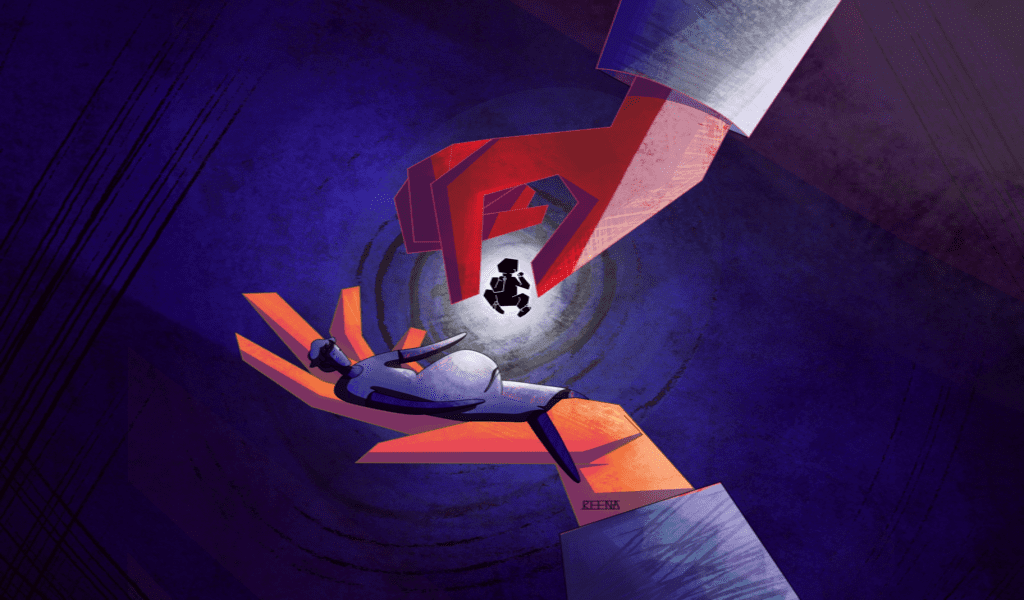
A girl child can grow up to become a doctor, engineer, astronaut, etc. Out of the million things that they can be sadly that is not what society wants, their aspirations are cut short due to centuries-old gender discrimination as they are murdered and buried before they can even exist in this world, such as female foeticide or sex-selective abortion has been a problem in many of the Asian societies because of their fond preference for a son due to primal customs of these societies which are mainly advanced because of the economic and social value of one gender above the other.
We often hear about the struggles of women in workplaces, households, and even positions of power but what about the ones who did not even take their first breath let alone face a struggle in the world ahead? This process of predetermination of gender and then abortion of a girl child is termed female foeticide, a social evil that still plagues this great nation to this day and one of the primary reasons is because of the unregulated Indian medical sector which provides these private practitioners to capitalize on the demand of the public which is fixated with having a boy.
Age-old Practice and Its Reasons
To understand sex-selective abortion or female foeticide and why it is so prevalent in India, the reason is in its historical context and background. This practice is not a stand-alone practice but a culmination of many customs which inculcate gender discrimination and eventually lead to families aborting a girl child. This gender discrimination is due to the value of women in India. The Indian society and many other Asian communities have been a dominant patriarchal society from its inception, where through the ages of empires women were considered livestock, loot, or objects to be won over by the victors of war.
This patriarchal structure of society has placed a great value on the son as through old customs they are the ones who used to inherit the property and to this day carry on the family name whereas a daughter does not, this is because in India a birth of a son increases the social and economic standing of the family. The birth of a daughter is considered a “bad investment” due to dowery and essentially after marriage being a part of another family hence taking that wealth away from the family a girl was born in. This perception of daughters as economic and social liabilities is due to factors like dowry costs, protection of the daughter’s chastity, and concern about her marriage. Significant reasons for gender discrimination and a preference for male heirs. This practice of sex determination may be centuries old.
Still, the early authenticated document of female foeticide comes from the British Era, and it had many traditional methods of killing a girl child for example poisoning, sedative overdose, strangulation, or just general neglect of the girl in the infant years. The technology developed and so did these methods of killing, In the 1980s ultrasound and Amniocentesis which is a process of inserting a needle through a pregnant woman’s abdomen to retrieve amniotic fluid, that would determine the sex of the fetus became so popular that they Indians referred to them often as sex test, this paved the way for prenatal determination of sex which led to what we know as sex-selective abortions.
Consequences of Sex-Selective Abortion or Female Foeticide

Continuation of such practices of sex-selective abortion or female foeticide will lead to an imbalance of gender in society. Sex ratio at birth or SRB is something that gives us an idea about the depth of such imbalances between men and women, SRB is calculated as the number of boys born to every 100 girls. Other Asian regions like South Korea and China have witnessed a high rate of SRB when new technologies like ultrasound and other techniques emerged which led to the exploitation of the practice of sex-selective abortion, similar is the case with India where son preference, economic restraints, and social value of a girl child leads to an increase in SRB. Especially in the regions of Punjab, Haryana, and Gujarat with SRB going as high as 125.
This imbalance would lead to a negative impact on the male population only, if the trend continues India will have a surplus of males in their 20s of about 28 to 32 million in numbers. This will have a severe psychological and productive impact on these surplus males since a scarcity of women would entitle the females to marry up, meaning the less desirable and economically weaker men would get filtered out of the prospect of marrying and starting a family. This is often looked down upon in orthodox societies like India and these men would eventually be left to live a nomadic lifestyle, socializing with other bachelors and finally become ostracised from society.
Another problem that will be faced is that due to such conditions the males are likely to have low self-esteem and be sexually frustrated which will lead to an increase in aggression and crimes against women. For example, in China when such imbalances occurred and women to marry were scares crimes like human trafficking of brides and child brides increased.
Another major consequence is that such women who are at the age to marry would become scarce in nature. The men would likely go for younger brides which will hamper the development of women, as younger brides are less likely to finish their studies and develop independent skills for the economy. The young brides also cultivate a risk of developing childbirth issues and hampering the mortality of both the child and the mother. The idea of men not finding girls to marry would promote prostitution as they would purchase sex and engage in riskier sex which might lead to an increase in Sexually Transmitted Diseases (STDs) like HIV or Herpes.
Legal Development and Challenges
The law has not been far behind in eradicating this social evil however rage cultural acceptance and preconceived notions about choosing the “better sex” have led to the failure of the implementation of the laws of the land successfully. The issue that this notion of a boy child and neglect of a girl child is so deeply engraved in the Indian societies that even after laws that have been put in place from the British rule of India like the Infanticide Act 1870 were termed ineffective.
In the 1970s the government tried to tackle this problem of sex-selective abortion again by introducing The Medical Termination of Pregnancy Act. This was a step in the right direction but extremely broad in its meaning as an act. The medical practitioners in this act were given powers to justify the abortion however these wide ambits of the act became its downfall as it did not help in stopping sex-selective abortion when newer technologies around the 1980s were discovered, alarmed by the falling rate of SR as it was recorded to be around to be 945 for 1000 boys in the 90s.
With the effort of feminists and lobbyists in the late 80s the government decided to regulate such predetermination practices and introduced the Pre-Natal Diagnostic Techniques Act also known as the PNDT Act. This was the first national law against sex determination. It included ways to keep in check the diagnostic procedures and asked for all the clinics and centers that offer such services where sex is determined to be registered with the government, but it failed to incorporate sperm sorting and regulate portable clinics and test centers. The Supreme Court made relevant amendments to the act in 2003 and made the regulations and policies more airtight to avoid any escape for misuse of these sex determination practices.
However, this present act has had many problems with its enforcement as the use of ultrasound is common in cases of pregnancy which poses a great deal for the law to determine the fine line between legal and illegal use of these practices, as after the knowledge of the gender the couple/family can approach different avenues to abort the child be it traditional or modern methods. This shifts the problem of determining whether the crime has occurred or not to the officials on the ground and gives powers to private healthcare centers and the medical community to take advantage of popular practice in demand. Some government officials regulating such work on the ground often are pressurized to ensure the enforcement of the act.
The Need for Self-Regulation within the Medical Community

The duty of doctors and the medical community should essentially be to stop such practices specialty after a legislative decision has been passed, but we see no change because of a lack of self-regulation as doctors consider these ultrasound techniques highly profitable, and having control of such technology makes them active bystanders to a social evil of female foeticide. The association in charge of the regulation of the community is the Indian Medical Association and the Medical Council of India. IMA and MCI being the regulatory bodies in order of discipline and ensuring good faith practice of the medical community in India have failed to successfully implement the PNDT Act and sex selection practices are left unpunished by these regulatory bodies. Public hospitals and clinics can still be checked on by the government.
However, private practitioners unregulated and far away from the eyes of the government in India take a considerable proportion of sex-selective abortions. The private clinics and practices are responsible for about two-thirds of abortions in India. The lack of regulations and care by the medical community is one of the primary reasons for the act’s unenforceability as the present authorities are not credible in dispensing their duties these associations should be effectively supported by some structural mechanism to help them better self-regulate and a revision and application of a stricter ethic code within the medical community is the step towards better self-governance of their community and which will be beneficial for the society and implementation of laws regarding such evil practices.
Conclusion
To fully eradicate this social evil known as female foeticide, it requires a joint effort of the society and government, as per the current provision and laws in place the enforceability of these laws is only because there is still a large population that believes in the concept of dowery, son preference, and female negligence. One side of India is applauded for its cultural diversity and its traditional roots but when these customs and practices simply look to eliminate an entire gender and systematically oppress them, that is when we decide to turn a blind eye to such a situation. The medical community really needs to reevaluate their regulatory bodies and their ethics code which makes them more responsive and adherent to government policies. A citizen should also be aware of such practices and effectively do so for the social welfare of India.
References
- Harrigan, Erica, Let Girls Be Born Elsewhere: Sex Selective Abortion in India and the Need for Self-Regulation within the Medical Profession (2004). Journal of Global Justice and Public Policy Volume 1:1 Fall 2014, Available at SSRN: https://ssrn.com/abstract=3172992
- Pervez, S. “Review of Sex Selective Abortion in India: Gender, Society and New Reproductive Technologies, edited by Tulsi Patel.” Journal of South Asian Development 5, no. 1 (2010): 172–175:https://doi.org/10.1177/097317411000500109.
- Lemoine, Kristi, and John Tanagho. “Gender Discrimination Fuels Sex-Selective Abortion: The Impact of the Indian Supreme Court on the Implementation and Enforcement Of The PNDT Act.” U. Miami Int’l & Comp. L. Rev. 15, no. 2 (2007): 203:https://repository.law.miami.edu/umiclr/vol15/iss2/4.
- Hesketh, T., Lu, L., and Xing, Z. W. “The Consequences of Son Preference and Sex-Selective Abortion in China and Other Asian Countries.” CMAJ: Canadian Medical Association Journal = Journal de l’Association Medicale Canadienne 183, no. 12 (2011): 1374–1377. https://doi.org/10.1503/cmaj.101368.
- Congressional-Executive Commission on China. 109th Congress. Annual Report. Washington, DC: U.S. Government Printing Office, 2005. Page 68. https://www.govinfo.gov/
- Nagpal, Sugandha. “Sex-selective Abortion in India: Exploring Institutional Dynamics and Responses.” McGill Sociological Review, vol. 3 (February 2013): 18-35. Accessed from https://www.mcgill.ca/msr/volume3/article2.
Submitted by Ashutosh Yadav.